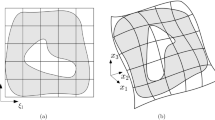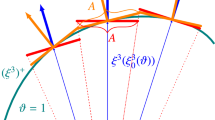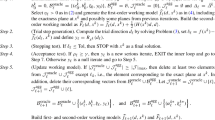Abstract
The adaptive variable p- and hp-version finite element method can achieve exponential convergence rate when a near optimal finite element mesh is provided. For general 3D domains, near optimal p-version meshes require large curved elements over the smooth portions of the domain, geometrically graded curved elements to the singular edges and vertices, and a controlled layer of curved prismatic elements in the thin sections. This paper presents a procedure that accepts a CAD solid model as input and creates a curved mesh with the desired characteristics. One key component of the procedure is the automatic identification of thin sections of the model through a set of discrete medial surface points computed from an Octree-based tracing algorithm and the generation of prismatic elements in the thin directions in those sections. The second key component is the identification of geometric singular edges and the generation of geometrically graded meshes in the appropriate directions from the edges. Curved local mesh modification operations are applied to ensure the mesh can be curved to the geometry to the required level of geometric approximation.






















Similar content being viewed by others
References
Luo XJ, Shephard MS, Remacle JF, O’Bara RM, Beall MW, Szabo BA, Actis R (2002) p-version mesh generation issues. In: Proceedings of the 11th international meshing roundtable, Ithaca, September, pp 343–354
Dey S, Shephard MS, Flaherty JE (1997) Geometry-based issues associated with p-version finite element computations. Comput Methods Appl Mech Engrg 150:39–55
Dorr MR (1984) The approximation of solutions of the elliptic boundary-value problems via the p-version of the finite element method. SIAM J Numer Anal 21(6):58–76
Babuska I, Suri M (1994) The p and h-p versions of the finite element method, basic principles and properties. SIAM Rev 36(4):578–632
Reddy JN (1999) Theory and analysis of elastic plates. Taylor & Francies, Philadelphia
Donaghy RJ, Armstrong CG, Price MA (2000) Dimensional reduction of surface models for analysis. Eng Comput 16:24–35
Actis RL, Engelstad SP, Szabo BA (2002) Computational requirements in design and design certification. In: Collection of technical papers—43rd AIAA/ASME/ASCE/AHS/ASC structures. Structural dynamics and materials conference, Denver, April, pp 1379–1389
Szabo BA, Sahrmann GJ (1988) Hierarchic plate and shell models based on p-extension. Int J Numer Meth Eng 26:1855–1881
Shephard MS, George MK (1992) Reliability of automatic 3D mesh generation. Comput Methods Appl Mech Eng 101:443–462
Luo XJ, Shephard MS, Obara RM, Nastasia R, Beall MW (2004) Automatic p-version mesh generation for curved domains. Eng Comput 20:265–285
Beall MW, Shephard MS (1997) A general topology-based mesh data structure. Int J Numer Meth Eng 40(9):1573–1596
Lieutier A (2004) Any open bounded subset of r n has the same homotopy type as its medial axis. Comput Aided Des 36:1029–1046
Patrikalakis NM, Gursoy HN (1990) Shape interrogation by medial axis transform. In: ASME advances in design automation, 16th design automation conference, vol 23, Chicago, pp 77–88
Etzion M, Rappoport A (2002) Computing Voronoi skeletons of a 3-D polyhedron by space subdivision. Comput Geom 21:87–120
Li XR, Shephard MS, Beall MW (2003) Accounting for curved domains in mesh adaptation. Int J Numer Meth Eng 150:247–276
Garimella R, Shephard MS (2000) Boundary layer mesh generation for viscous flow simulations in complex geometric domain. Int J Numer Meth Eng 49(1–2):193–218
Szabo BA (1986) Mesh design for the p-version of the finite element method. Comput Methods Appl Mech Eng 55:181–197
Luo XJ (2005) An automatic adaptive directional variable p-version method in 3-D curved domains, Ph.D thesis. Rensselaer Polytechnic Institute
Dey S, O’Bara RM, Shephard MS (2001) Curvilinear mesh generation in 3D. Comput Aided Des 33:199–209
Sherwin SJ, Peiro J (2002) Mesh generation in curvilinear domains using high order elements. Int J Numer Meth Eng 53:207–223
Farin G (1992) Curved and surfaces for computer aided geometric design. Academic Press, New York
Acknowledgments
This work was supported by the National Science Foundation through SBIR grant number DMI-0132742.
Author information
Authors and Affiliations
Corresponding author
Rights and permissions
About this article
Cite this article
Luo, XJ., Shephard, M.S., Yin, LZ. et al. Construction of near optimal meshes for 3D curved domains with thin sections and singularities for p-version method. Engineering with Computers 26, 215–229 (2010). https://doi.org/10.1007/s00366-009-0163-0
Received:
Accepted:
Published:
Issue Date:
DOI: https://doi.org/10.1007/s00366-009-0163-0




